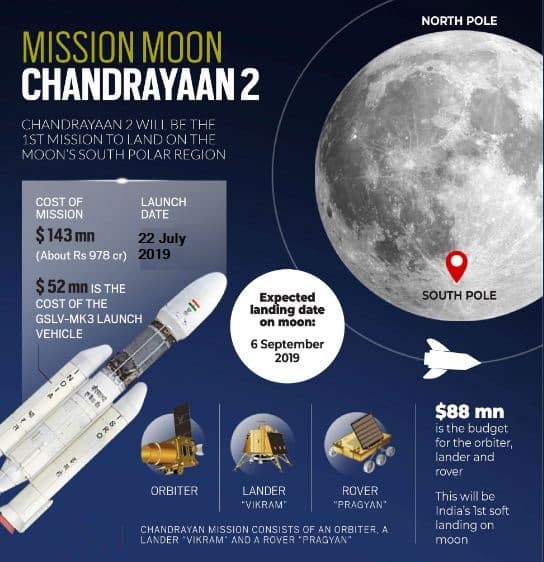Chandrayaan-2 was India's second lunar mission, launched by the Indian Space Research Organisation (ISRO). It was a more ambitious mission compared to Chandrayaan-1, as it aimed to not only orbit the Moon but also land a rover on its surface. The mission's main objectives were to further explore the Moon's surface, study its mineralogy, search for water ice, and demonstrate India's technological capabilities in lunar landing and rover operations.
Chandrayaan-2 consisted of an orbiter, a lander named Vikram, and a rover called Pragyan. The spacecraft was launched on July 22, 2019, using the Geosynchronous Satellite Launch Vehicle Mark III (GSLV Mk III) from the Satish Dhawan Space Centre in Sriharikota, India.
After a successful journey to the Moon, the lander Vikram attempted a soft landing near the lunar south pole on September 7, 2019. However, during the landing sequence, contact with the lander was lost just moments before touchdown, resulting in a partial mission failure. Despite this setback, the orbiter component of Chandrayaan-2 remains operational and continues to orbit the Moon, collecting valuable scientific data.
Chandrayaan-2 represented a significant step for India in its pursuit of lunar exploration and showcased the country's technological advancements in space. It also highlighted India's commitment to scientific research, technological innovation, and international collaboration in space exploration. The mission provided valuable insights into the Moon's south pole region and contributed to the global scientific community's understanding of Earth's celestial neighbor.
Objective of Chandrayaan-2
- Scientific Exploration: The primary objective of Chandrayaan-2 was to further explore the Moon's surface, mineralogy, and composition. By studying the lunar south pole region, which had not been extensively explored before, scientists aimed to gather data and insights that would contribute to our understanding of the Moon's geology, origin, and evolution. The mission sought to expand our knowledge of the lunar surface and provide valuable scientific data for research purposes.
- Lunar Geology and Water Ice: Chandrayaan-2 aimed to study the distribution of elements and minerals on the Moon's surface, including the presence of water ice. The discovery of water on the Moon is of particular interest because it could potentially support future human space exploration. Water can be used for sustaining human life, generating breathable air, and producing rocket fuel, making it a valuable resource for future lunar missions.
- Technological Advancements: Chandrayaan-2 aimed to showcase India's technological capabilities in lunar landing and rover operations. Developing and successfully executing a soft landing and rover deployment on the Moon required advancements in spacecraft design, navigation systems, and autonomous operations. By undertaking this mission, India aimed to demonstrate its engineering prowess and technological expertise in space exploration.
- National and International Collaboration: Chandrayaan-2 involved collaborations with various international partners. The mission included scientific payloads and contributions from other countries, such as the laser retroreflector array from NASA. Collaborations with international space agencies allowed for shared resources, expertise, and scientific cooperation, fostering stronger ties within the global space community.
- National Pride and Inspiration: Like Chandrayaan-1, Chandrayaan-2 aimed to boost national pride and inspire the younger generation to pursue careers in science and technology. The mission was a source of pride for India, showcasing the country's capabilities in space exploration and reinforcing its position as a significant player in the global space arena. The mission also aimed to inspire and motivate future generations to actively participate in scientific research and technological advancements.
Overall, the Chandrayaan-2 mission was driven by the goals of scientific exploration, lunar geology research, technological advancements, international collaboration, and national pride. It aimed to expand our understanding of the Moon, pave the way for future lunar missions, and position India as a key player in space exploration.

Comments
Post a Comment